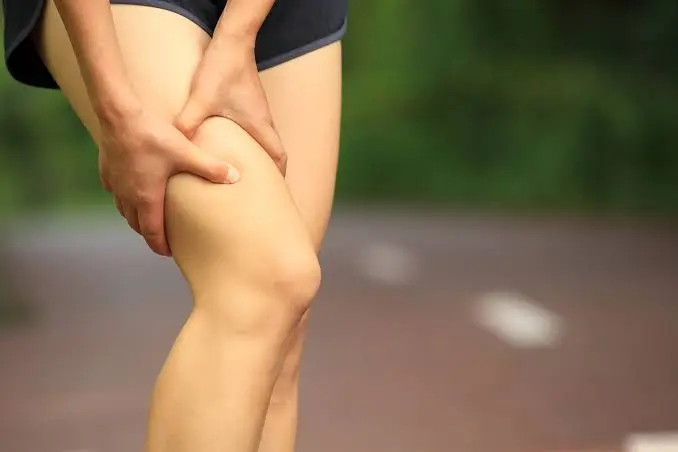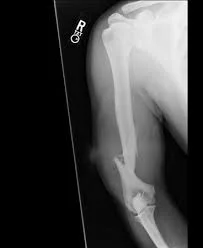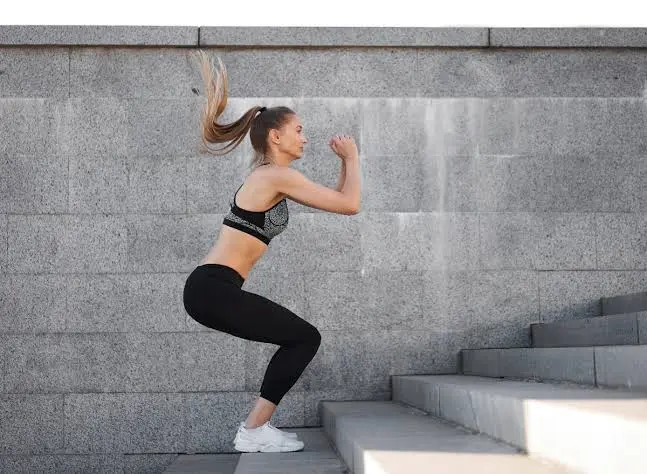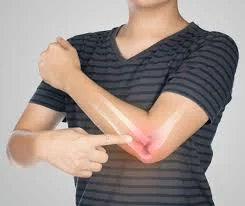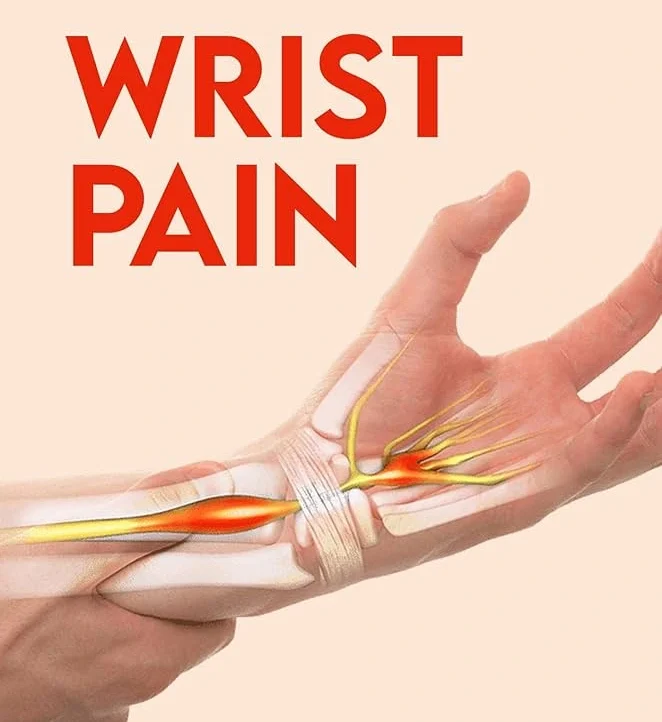Quadriceps Muscle Pain
Table of Contents
What is a Quadriceps Muscle Pain?
Quadriceps muscular strain, overuse of work, athletic activity, and knee jerks are the main causes of quadriceps muscle pain, which is primarily felt in the front side of the leg (above the knee).
Four muscles on the front of the leg combine to form the quadriceps muscle. This quadriceps muscle is in charge of extending/straightening the knee joint and flexing the hip joint. It is suggested that the patient has quadriceps muscle pain if they have pain in the front of their thigh. Numerous injuries to the quadriceps muscle might cause pain in that area.
The acronym RICE stands for rest, ice, compression, and elevation, and it is used to treat quadriceps muscle soreness. Utilise physiotherapy occasionally to aid in restoring muscle strength and range of motion, or ROM. It’s a very important muscle of the body to extend out the leg from the knee joint.
Anatomy of the quadriceps muscle
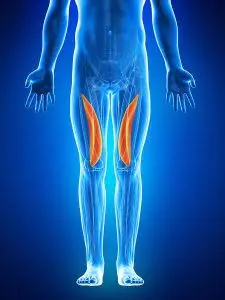
The quadriceps femoris is an extensor of the knee and a hip flexor. It is composed of the rectus femoris, three vastus muscles, and one other muscle. Together, they make up the majority of the thigh and are among the body’s strongest muscles.
It is situated in the thigh’s anterior compartment. The four subcomponents consist of
- Rectus femoris
- Vastus Lateral
- Vastus medialis
- Vastus Intermediates
Origin of the quadriceps muscle
The quadriceps tendon connects the quadriceps femoris muscles to the patella, where they combine proximal to the knee.
- Vastus Lateralis
Proximal attachment: Derives from linea Aspera’s lateral lip and greater trochanter.
Actions: Stabilises the patella and extends the knee joint.
- Vastus Intermedius
Proximal attachment: The femoral shaft’s anterior and lateral surfaces.
Actions: Stabilises the patella and extends the knee joint.
- Vastus Medialis
Proximal attachment: Medial lip of linea aspera; intertrochanteric line.
Actions: Because of its horizontal fibres at the distal end, it stabilises the patella and extends the knee joint.
- Rectus Femoris
The origin of the Rectus Femoris Attachments is the ilium, which is located directly above the acetabulum. It joins to the patella via the quadriceps femoris tendon and runs straight down the leg (rectus is the Latin word for straight).
Actions of the quadriceps muscle
The quadriceps’ only muscle that crosses both the hip and knee joints.
Nerve supply of quadriceps muscle
These muscles are innervated by the femoral nerve. (L2, L3, L4)
Arterial supply of quadriceps muscle
the artery circumflexing the lateral femur.
Action in the daily life of quadriceps muscle
- The purpose of the quadriceps is to stretch (straighten) the knee. The vastus medialis adducts the thigh, stretches and rotates it externally, and stabilises the kneecap.
- Running, cycling, leaping, and kicking use the quadriceps mainly. For instance, jump-heavy sports like basketball.
- In daily life, they facilitate squatting, walking, climbing stairs, and getting out of a chair.
- They are employed in the beginning of a stride in both running and walking, and they are heavily utilised on descents.
Changes in the Quadriceps Muscle When Illness Is Present
When systemic illnesses are present, skeletal muscle adapts. This indicates that muscle activity alters volumes and metabolism, exacerbating the clinical picture, for example
- Growing Older
The architecture and function of the quadriceps muscle alter as we age due to muscular adaptation. Sarcolemma causes the muscles to lose volume and mass, which weakens their coordination and strength. Denervation processes result in the loss of motor units while the proportion of red fibres rises. Fibrosis processes and intramuscular fat increase as a result.
- Chronic Heart Failure with Chronic Obstructive Pulmonary Disease (COPD)
Reduced quadriceps femoris muscle mass, increased connective tissue, and fibrosis phenomena are associated with chronic and ingravescent respiratory disorders as COPD. This results in a reduction in strength, balance, and contractile capacity when walking or standing. Muscle fatigue occurs more quickly as a result of an increase in anaerobic fibres at the expense of oxidative fibres. Along with a localised and systemic metabolic change (increased cardiovascular risk), there is an increase in intramuscular fat. The functional change of the muscle affects females more severely than males.
- Multiple Illnesses
The quadriceps muscle has a loss of bulk and strength in multiple sclerosis, accompanied by an increase in anaerobic fibres and a decrease in oxidative fibres. White fibres become more numerous, but they also experience greater atrophy. promote fibrosis and intramuscular fat accumulation.
Causes of quadriceps muscle pain
Bruising or contusion
A contusion or bruise, resulting from a direct hit to the anterior thigh, is the most frequent source of damage and bleeding to the blood vessels within the quadriceps muscle. The discomfort associated with this illness is brought on by inflammation of the surrounding muscle.
The quadriceps muscle’s rectus femoris is the one that gets confused the most since it is the muscle that is closest to the anterior thigh’s surface.
When there is severe bleeding into the quadriceps muscle, it is because of compartment syndrome. This condition causes the compartment to pressurise the quadriceps muscle above blood pressure, which keeps the oxygen-rich blood from reaching the muscle tissue.
Tension to the quadriceps muscles
Overuse and overstretching cause straining in the quadriceps muscle. Tendon, muscle, and occasionally both types of fibres are strained in this strain. These muscle strains are divided into different categories based on how serious the damage is.
Three distinct grades of muscle strains are evident. Muscle fibres that are just stretched, not torn, are involved in
- Grade 1 strains.
- Grade 2 strains: These involve more substantial injury, such as a partially torn muscle.
- Grade 3 strains: These happen when a muscle rips entirely.
Moreover, quadriceps pain from tendinitis The term “quadriceps tendinitis” refers to inflammation of the tendon that runs above the patellar bone. Quadriceps muscle soreness is another cause of patellar tendinitis. In this disease, inflammation occurs below the patella at the knee.
Another disorder is called peri-patellar tendinitis, or Jumper’s knee. It is characterised by a persistent degeneration of the quadriceps tendon, where muscle fibres change into tendons immediately above the patella, or kneecap.
Rupture of the tendon
An entire rupture of the patellar tendon or quadriceps can occasionally cause severe agony, making it impossible to fully extend and straighten the knee joint.
Signs and symptoms of Quadriceps muscle pain
The kind and intensity of the quadriceps muscle injury determine the signs and symptoms of quadriceps discomfort.
- Pain in the patient’s anterior thigh
- feeling of cramping in the quadriceps muscle
- Skin discoloration or bruises at the quadriceps muscle
- There is tenderness in the front thigh.
- felt as though something was tearing or popping in the quadriceps muscle.
- The evaluation indicates a decline in the range of motion. The evaluation demonstrates the leg’s decreased range of motion.
- The patient experiences pain when engaging in routine activities such as walking and climbing stairs.
- Occasionally, the patient has changes in their anterior thigh sensation.
Risk factor Qquadriceps muscle pain
Bruises
Contusions caused by objects or other people rank as the primary cause. This disorder results in bleeding and injury to the muscle fibers. Thus, there is muscle trauma, such as a severe crush injury and a femur fracture that results from it
Compartments syndrome
When the pressure inside the quadriceps muscle compartment is so high that it precludes enough blood flow from the muscle itself, this condition—a surgical emergency—occurs. This disorder results in the death of the quadriceps muscle’s muscle cells because lack of blood causes muscle and nerve damage.
Stress
Quadriceps muscle strains result from overuse that is repeated, causing the muscle fibers to become irritated and occasionally to partially rip. This strain is frequently observed in weightlifters and other athletes who consistently complete weight training, but it also happens to manual laborers who occasionally lift larger goods. When the patient is running or kicking, partial tears happen.
Tendinitis
This ailment manifests as inflammation of the tendon that connects the tibial tubercle to the quadriceps muscles. In particular, inflammation of the patellar tendon causes pain and swelling in the region [patella] beneath the kneecap.
It happens as a result of issues with recurring injuries, causing damage to the tendon. Additionally referred to as peri-patellar tendinopathy, The front of the thigh begins to degenerate and scar as a result of the acute inflammation. The most prevalent cause of this injury is repeated participation in sports involving high jumping, such as basketball and volleyball.
Rupture of the tendon
The quadriceps and patellar tendon tear or rupture when the quadriceps muscle is violently contracted while the knee joint is flexed. Patients over 40 years old are more likely to experience this tendon rupture. Less often and usually in younger individuals, this tendon rupture occurs. Certain conditions can raise the chance of an underlying medical condition rupturing, along with specific treatments, such as diabetes mellitus
- Being overweight
- Gout
- Rheumatoid arthritis
- Renal illness
- SLE, or systemic lupus erythematosus
- Use of anabolic steroids
- Metabolic arthritis
Diagnosis
- The health care practitioner (a doctor or therapist) will first obtain a thorough history before performing a physical examination. Certain diagnoses made in the clinic account for part of the discomfort, but other disorders must be documented.
- Imaging Simple X-rays of the anterior thigh are useful in detecting any related patellar or femur bone fractures. If Myositis Ossificans occurs, an X-ray will also show a bony growth that forms inside the muscle.
- MRIs are sometimes required for diagnosis. To diagnose tendon rupture, use ultrasound to ascertain the partial versus.
- blood examinations – To diagnose significant muscle damage, levels of creatine phosphokinase, or CPK, are examined.
- CPK = Creatine phosphokinase seeps out of injured muscle fibers and accumulates and will be elevated.
Treatment Quadriceps muscle pain
P.E.A.C.E. protocol for quadriceps muscle pain
When treating an injury in the short term (acute phase), the P.E.A.C.E protocol is advised.
- Protect: Minimise movement for around one to three days is what the term stands for.
- Elevate: To encourage fluid (edema) to drain out of the tissues, keep the limb above the heart. Although there is no evidence to support the use of elevation, it is nevertheless frequently employed because there are no hazards.
- Aid in healing: The several stages of inflammation aid in the healing of injured soft tissues. Therefore, reducing inflammation with medicine may have a deleterious effect on tissue repair over the long run, particularly if higher dosages of anti-inflammatory drugs are taken.
- Condensation: Tissue bleeding and fluid collection (swelling) may be minimized by the use of tape or bandages.
- Education: Medical professionals should inform their patients of the advantages of taking an active role in their recovery. When compared to an active approach, the effects of passive modalities (such as electrotherapy, manual therapy, and acupuncture) on pain and function are negligible in the early stages following injury. They might even be long.
Electrotherapy
In physical therapy, electrotherapy is one of several pain treatment techniques utilized for quadriceps discomfort.
TENS, IFT, and SWD (short wave diathermy) are used to relieve pain. If there are any sore spots or edema, please contact US [ultrasound].
- Ultrasound
Tissue healing has been studied with ultrasound.
improves blood flow and range of motion.
To lessen discomfort and edema
- Cryotherapy
Applying cryotherapy—which involves applying ice packs and taking cold water baths to the affected area—can help reduce swelling and inflammation. It is advised to apply cold continuously for 15 to 30 minutes at a time, several times a day.
- TENS
TENS, or transcutaneous electrical nerve stimulation, has the potential to lessen pain and spasms in the muscles.
Exercises for quadriceps pain
Stretching exercises for quadriceps muscle pain
Lunging Hip Flexor Stretch
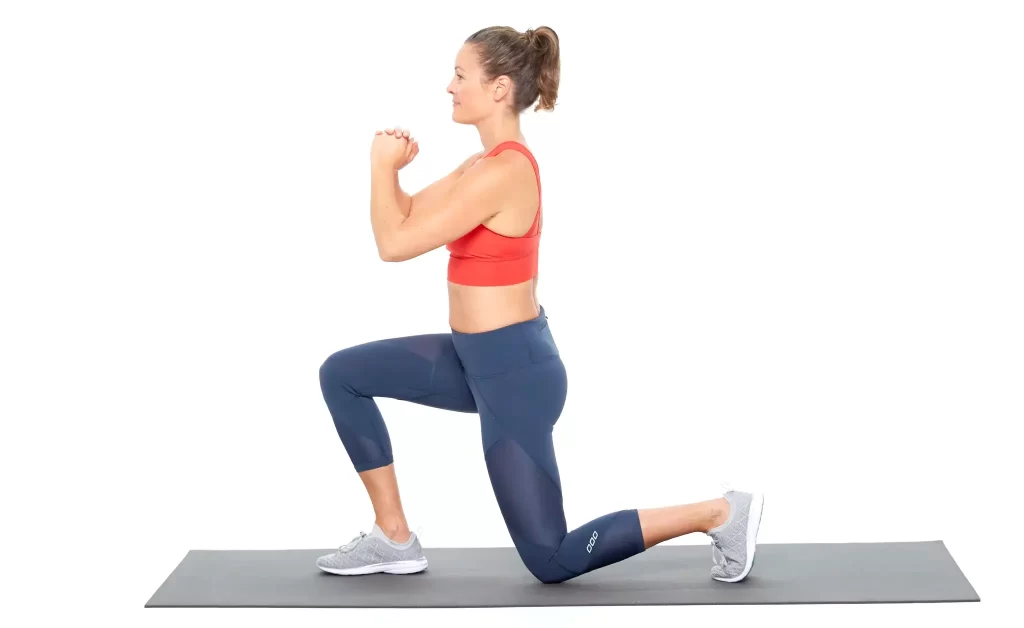
- Kneeling is the starting posture for this stretching exercise.
- Position yourself on your left knee while keeping your right shin on the ground.
- Try performing this stretch on a yoga mat when they find it difficult to extend their rear leg on the ground.
- Subsequently, bring the right leg back behind the body.
- Has to be Keep your right foot pointed towards the ceiling.
- The patient should next press their torso forward while placing both hands on their right knee.
- Has to keep the torso in place, and align the head.
- The patient feels a stretch in their left leg and hips in this position.
- For thirty seconds, maintain this elongated posture. As progression hold time increases make exercise more effectively full
- Continue stretching three times in one treatment period and 3 times in a single day.
Stretching Your Quadriceps While Standing:
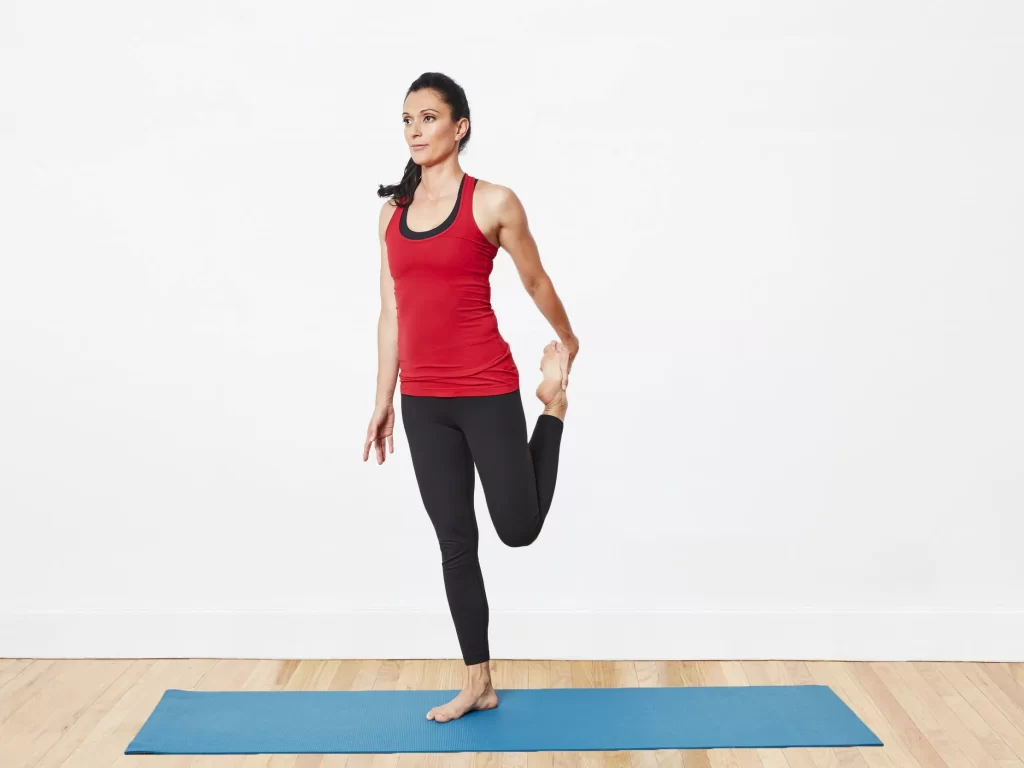
- Standing in the starting posture for the stretching position.
- Next, raise your left arm as far in front of your body as possible.
- This stance aids in maintaining the body’s equilibrium.
- Adjust this exercise by having the patient grab onto the back of a chair or wall for their level of difficulty.
- then Grip your left ankle and bend to your left knee.
- Reposition the foot that is injured behind your torso.
- Next, attempt to use your hand to bring your leg up and back onto your ankle joint.
- must be maintained in alignment with the head and torso.
- For thirty seconds, maintain this elongated posture.
The Quad Stretch While Lying Down
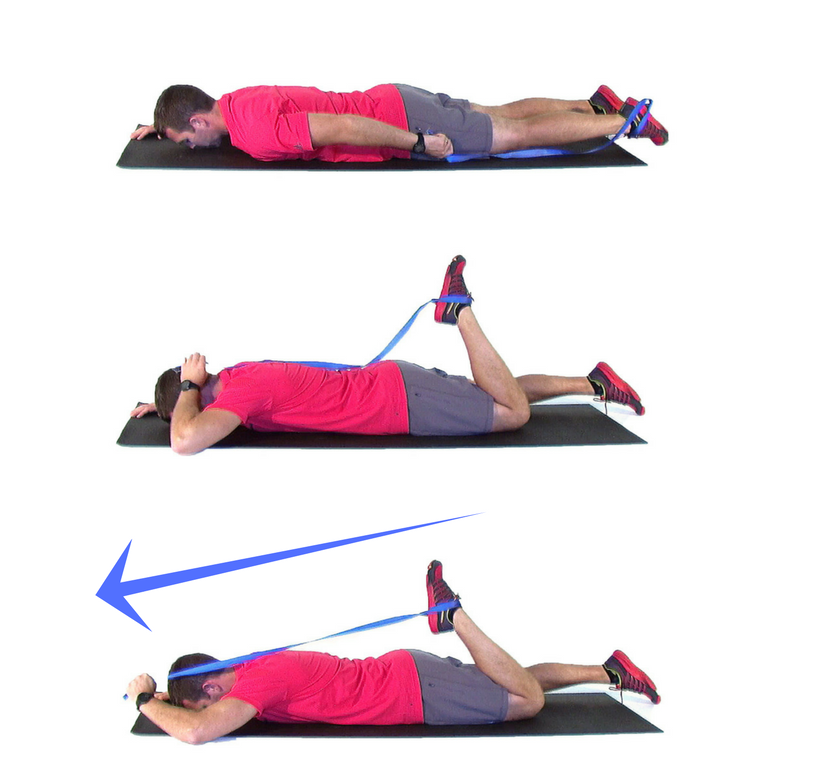
- The finest quad stretches target every part of your leg, including the hip, thigh, and foot, in addition to the quadriceps. Both individuals who would rather lie down than stand up and those who have knee pain can benefit greatly from the lying quad stretch.
- Place your left hand over your head and lie face down. As an alternative, you can carry out this stretch while lying on your side.
- To stabilize yourself, draw your right foot towards your butt and bend your left knee after a few seconds.
- Hold onto your ankle and hold that position for thirty seconds. Change sides, bending and drawing your left foot towards your back.
The Quad Stretch on Your Knees
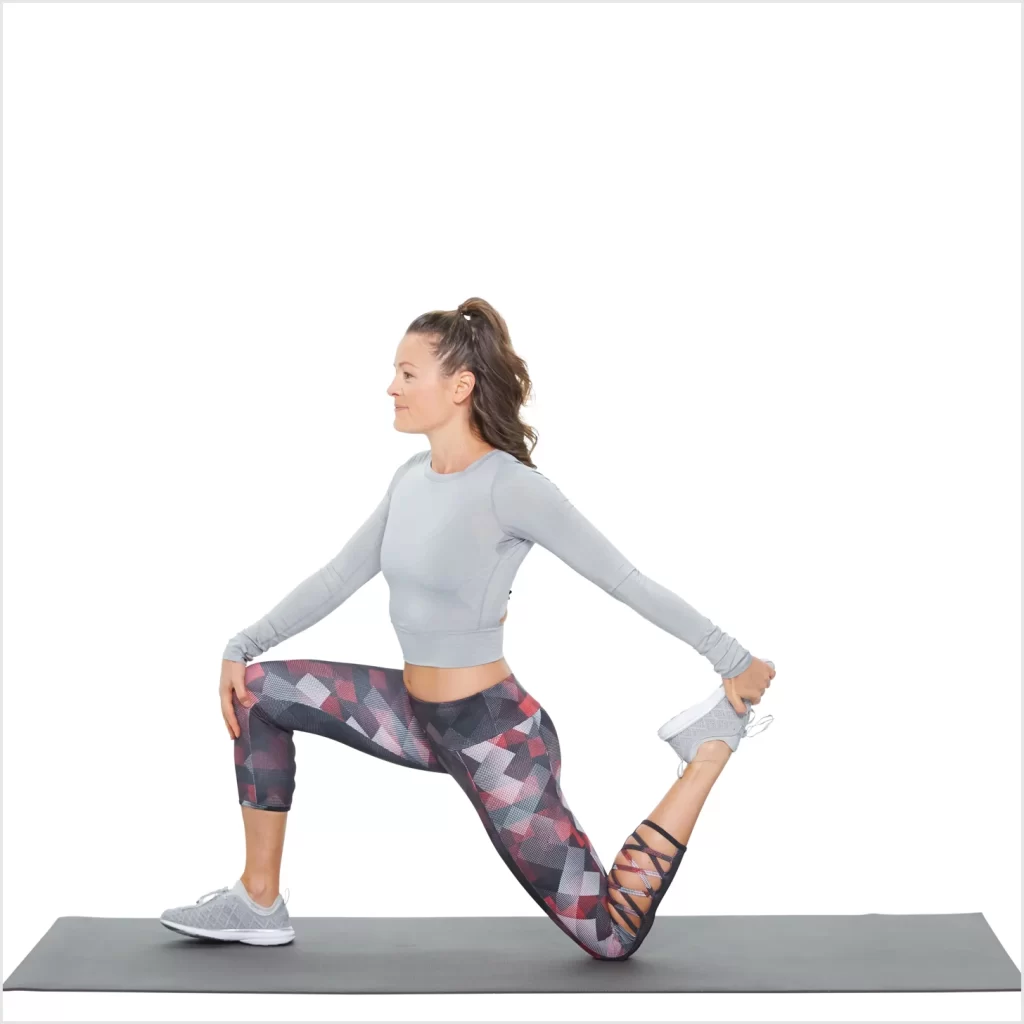
- This posture, which is a little different from a quad stretch, will assist in relaxing the muscles directly above the knee joint, enhancing the range of motion and reducing the risk of knee pain.
- Start the stretch with your left foot forward, in the high lunge position. Give your right knee a gentle downward push before pausing to regain your equilibrium.
- When you’re ready, extend your right arm back and grasp your toes or ankle, whatever is most convenient. Maintain a stable body for 30 seconds while holding the position. For an additional hip flexor stretch, push a little bit harder.
- Return to the starting position gradually while switching from your left to your right foot. And As progression hold time increasing make exercise more effectfull
Lying Pigeon Advancement of stretching
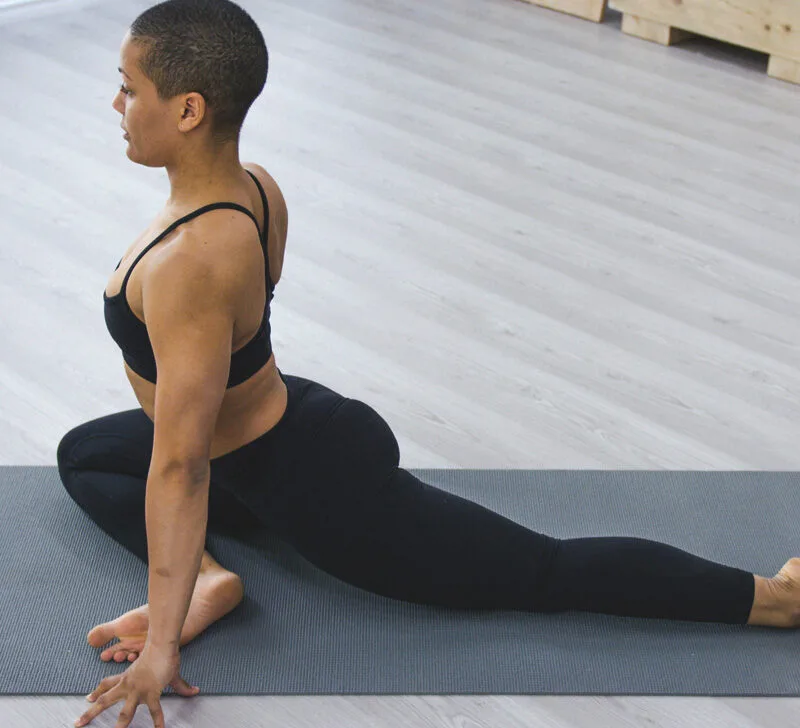
- Yoga is the source of some of the best quad stretches. This specific pose is a great method to stretch your quads and your quadratus lumborum, which is your back. It can help you advance to the pigeon and pigeon twist stretches and is also an excellent hip flexor stretch.
- Lay face down on a mat placed on the ground.
- Wrap a resistance band around your left foot, making sure the extra is in a place where you can get to it. Use a towel in place of a resistance band if you don’t have one on hand.
- Use your left hand to seize the band. Bend your left knee while maintaining your right leg extended and your toes pointing skyward. Pull forward with the resistance band until you feel the length. Pull harder after 20 seconds of holding.
The Pose of the Frog
- This can be the ideal stretching stance for you if you want to open up your thighs and gluteus Maximus. Stretching your arms, chest, and shoulder blades will also be beneficial.
- Start with resting on your stomach with your elbows supporting your upper body.
- Reach back to grab onto your feet while bending both of your knees. By now you should be feeling the stretching. If you are now too immobile to accomplish this, cover the space with a towel.
- After adjusting your fingers to point in the same direction as your toes, slowly raise your elbows to the upside.
Importance Quadriceps muscle Stretch
The proper post-exercise stretch session is essential if you want to get the most out of your workout, regardless of whether you’re preparing for an hour of intense leg work or you’re concentrating especially on growing your quadriceps muscles. In addition, dynamic stretches performed before a boxing match serve to increase your muscles’ range of motion and adaptability, enabling you to move more fluidly around your opponent and land punches with greater force.
The quadriceps’ main job is to facilitate knee mobility. The vastus medialis, vastus intermedius, vastus lateralis, and rectus femoris are the four individual muscles that make up your quadriceps. Every time you bend and straighten your knee, your quadriceps are worked. Nearly every leg movement involves your quadriceps, which collaborate with other muscles like the glutes and hamstrings to facilitate effective running, jumping, and balance. Squats, leg presses, and lunges are a few popular quad workouts. In general, quadriceps exercises are any movement that activates the fast- or slow-twitch muscle fibres in your leg muscles.
With repeated use, our quadriceps muscles are prone to inflammation, discomfort, and tightness. Quadriceps tendinopathy, or inflammation of the tendons that connect your quadriceps muscles to your knee joint, is another possibility. Exercises or activities of everyday living involving knee extension and flexion, like bending over and picking something up, might aggravate knee tendinopathy. Knee pain can result from overcompensation of a quadriceps problem, and it can even induce Chondromalacia patellae, sometimes known as “runner’s knee.” Making time for quadriceps stretches is crucial since all of your quadriceps muscles, but particularly the rectus femoris, are important for knee flexion and extension. Not to mention how important it is to stretch your hamstrings properly. Hamstring stretches are a different topic entirely.
You may lower your chance of injury and promote recovery by making sure you warm up before doing quadriceps exercises and include stretches and foam roller therapy after a workout.
Static stretching, which covers some of the positions covered below, and dynamic stretching are the two primary types of stretching. Dynamic stretches involve movement and
Strengthening Exercises for quadriceps pain
Static Quadriceps Exercise (SQE)

- This exercise begins with a protracted sitting or supine position.
- Next Place a pillow, sandbag, or towel fold beneath the knee.
- Next, attempt to press the knee against the bed.
- For ten seconds, hold this push, and then take a quick break to unwind.
- Do these static quadriceps exercise ten to fifteen times in a single session?
- Perform three sets of this workout each day.
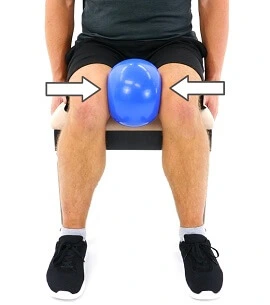
Vastus medialis exercises of activation
place the ball between the medial side of two knee joints, and then ask to squeeze the ball between knee joints. As progression hold time increasing make exercise more effectfull
- The muscles of the Vastus medialis can be strengthened primarily using this exercise.
- The exercise begins with you in a protracted sitting or supine position.
- Next, place the VMO board and towel roll beneath the knee joint.
- Next, bring your toes up towards your shin. Next, fully extend the knee joint.
- Maintain this exercise posture for ten After ten seconds, take a moment to unwind.
- In one session, perform this vastus medialis oblique exercise ten times. As progression hold time increasing make exercise more effectfull
Slip of the heels on bed
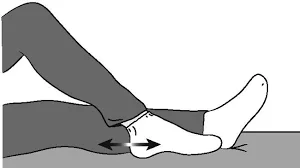
- It is also known as heel slide or heel drag exercise. For the action of knee flexion.
- With your knee pointed upward and your heel moving towards your buttocks, bend your undamaged leg. Take up this role.
- Now, extend your wounded leg as far as it will comfortably allow in a corresponding bending motion.
- Reposition the heel till the damaged leg is straight once again.
- Repeat the heel slide with your injured leg while keeping your damaged leg bent up.
Raise your legs straight
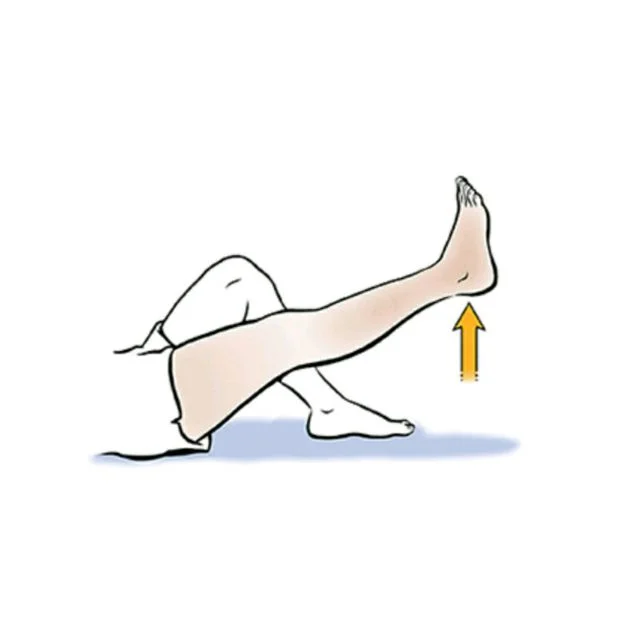
- With your wounded leg extended out in front of you and your uninjured leg bent up at the knee, take a seat on the floor.
- Cinch your thigh muscles and pull the toes of your afflicted leg towards you. This will push the back of your knee down so that your lower leg extends. Lift your leg off the ground while keeping your knee straight and your muscles contract.
- After a short while, maintain this posture by lowering your leg back to the floor.
- Carry out this motion again.
- Make sure your knee stays straight and your hips stay in contact with the floor at all times.
Inner range quadriceps contraction
- With your legs out in front of you and a rolled-up towel beneath your knees, take a seat on the floor.
- Tighten your thigh muscles to straighten your knee while using the damaged leg, keeping your toes pointed upward. Make sure your knee stays in touch with the towel at the rear.
- Maintain this stance, unwind, and do it again. As progression hold time increasing make exercise more effectfull.
Seated knee flexion
- With your shoulders back and your legs bent comfortably at the knees, take a seat in an upright chair.
- Stretch one lower leg straight out in front of you without adjusting your hips.
- Return your knee to its neutral sitting position.
- Repeat after switching legs.
Stand while seated (no arms)
- With your shoulders back and your legs bent comfortably at the knees, take a seat in an upright chair.
- Fold your arms over your torso.
- Without using your arms to support or propel yourself up, stand erect.
- Return to your seat slowly and repeat.
Extensions of the legs
- Sitting is the beginning position for this exercise.
- Sitting up too tall in the chair is the patient.
- Place the feet level on the ground and space them hip-width apart.
- Next Gaze directly ahead.
- Stretch your thigh muscles as high as you can without getting your buttocks off the chair while on the track.
- In one session, perform ten repetitions of this leg extension exercise.
- Perform these three sessions of workout.
Wall squats

- The workout begins with the person standing close to the wall.
- Feet must remain on the ground.
- Next, Place your back up against a wall.
- Place your feet shoulder-width apart.
- Next, Maintain the back and pelvis against the wall while bending the knee joint slowly.
- But do not sincerely bow down to them.
- For ten seconds, maintain the exercise position.
- Ten repetitions of these wall squats can be done in a single session.
- Perform three sets of this workout each day.
Partial squats
- You can develop your quadriceps muscles with this workout without putting too much strain on your knees.
- The standing squat is the beginning posture for this exercise.
- The feet are shoulder-width apart in this position. Next For balance, place your hands on your hip joints or out.
- Has to be Gazing straight ahead and then lowering yourself gradually to the point of about a 10-inch squat.
- The midway point of a complete squat is this position.
- Five seconds is the duration of the hold; after that, push through to your heels to stand up.
- Ten half-squat repetitions should be performed in a single session. As progression hold time increasing make exercise more effectfull.
From Knee to Chest
- The workout begins in a supine position.
- Next, slowly draw to one knee joint and through to the chest.
- For thirty seconds, maintain this exercise posture.
- Afterward, extend your arms back out in a straight position. On the other side of the body, perform a similar type of exercise.
- Ten times throughout one session, perform this Knee-to-chest exercise.
Home remedies for quadriceps muscle pain
The RICE technique is used at home to treat the majority of quadriceps muscle discomfort.
Use Ibuprofen together with an anti-inflammatory medication to manage pain.
However, the healthcare professional needs to be notified if the patient’s suffering at home gets worse.
Continually Emergency care should be sought if the knee joint cannot be extended or straightened, or if severe pain and swelling have not subsided after five or six days and the limb is numb.
Recovery time of quadriceps muscle pain
The intensity and underlying reasons for the quadriceps muscle pain determine how long it takes to recover.
Complication of quadriceps muscle pain
- The body lays down extra calcium as part of the healing process when the quadriceps big muscle is injured. Myositis ossificans is the name of this condition, which causes pain and a reduction in range of motion (ROM) in the affected limb.
- Surgery is required to remove the extra bone in this condition.
- Trauma to the anterior compartment of the thigh, which houses the quadriceps muscle group, can result in compartment syndrome.
- Mostly results from crush injuries, with femur fractures serving as the common cause.
- It is a surgical emergency that must be opened to release the pressure and avoid long-term harm to the muscles and nerves.
Prevention of quadriceps muscle pain
- It is possible to avoid quadriceps muscle soreness, but you will need to take some preventive measures.
- Always exercise caution when participating in sports to prevent injuries to the anterior thigh.
- Prevent overuse of the exercise from causing damage to the tendon.
- Steer clear of stretching the quadriceps muscle to prevent strain.
- Always warm up and cool down before and after your regular workout.
Prognosis of quadriceps muscle pain
Depending on the severity of the damage, recovering to full fitness following a quadriceps muscle injury may take days, weeks, or months.
The majority of contusion injuries and Grade 1 and 2 muscular strains may typically be healed in a few weeks with proper exercise and therapy.
It could take many months for a fully torn quadriceps muscle to heal, during which time you won’t be able to start training or participating in sports.
Summary
Because the quadriceps muscles cross both the hip and the knee, they extend over the front of the thighs and are frequently injured. Sports like basketball, football, and soccer that require a lot of running or kicking can often cause quad pain in players. Quadriceps strains are common because the quad muscles sustain a large portion of the body’s motion when it is standing or moving. It’s an important muscle for living a quality of life and for sports activity for athletes.
FAQs
1.5 months or more duration is required for total recovery of muscle.
Relax. For a few days or until your doctor gives the all-clear, rest the affected muscle.
Ice. Spend twenty minutes applying ice to the injury for every hour that you are awake.
compression. Swelling can be reduced by applying an elastic bandage around the affected muscle. A rise in altitude. Drugs. Warmth.
By extending your quadriceps, you can relieve pressure on the front of the knee joint and regain full range of motion.
Ice should be applied to an acute injury to reduce swelling during the first two to three days following the injury. Following this heat is important.
References
- Quadriceps muscle. (n.d.). Physiopedia. https://www.physio-pedia.com/Quadriceps_Muscle
- Ladva, V. (2022b, March 8). Quadriceps muscle pain: Cause, Symptoms, Treatment, Exercise | Mobile. Samarpan Physiotherapy Clinic. https://samarpanphysioclinic.com/quadriceps-muscle-pain/#Lunging_Hip_Flexor_Stretch
- Practice Plus Group. (2021, May 25). Quadriceps muscle injuries – Practice Plus Group MSK & Diagnostics. Practice Plus Group MSK & Diagnostics. https://www.mskdiagnostics.co.uk/patients/resources/upper-leg/quadriceps-muscle-injuries/
- Quadriceps strain: care instructions. (n.d.). https://myhealth.alberta.ca/Health/aftercareinformation/pages/conditions.aspx?hwid=abo3610
- What is Quadriceps Muscle Strain? Symptoms, Causes, Diagnosis & Physiotherapy Treatment of Quadriceps Muscle Strain. . .. (n.d.). Cbphysiotherapy. https://cbphysiotherapy.in/condition/quadriceps-muscle-strain
- Morales-Brown, L. (2023, December 6). What to know about the quadriceps muscles. https://www.medicalnewstoday.com/articles/quadriceps-muscles#

